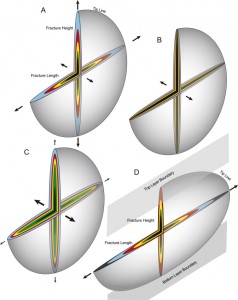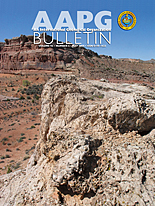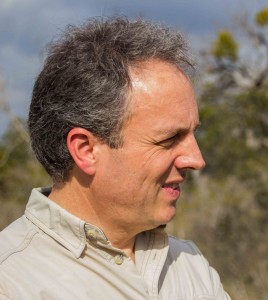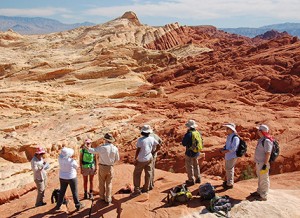Geochemistry & structure
Structural diagenesis is the study of the relationships between deformation or deformational structures and chemical changes to sediments. Structural diagenesis supports research and student training on the increasingly important phenomena in sedimentary basins that are of great intrinsic and practical interest. The linked geochemistry and structure research program based at the Bureau of Economic Geology is a central part of the program.
Dr. Peter Eichhubl is a leader in linked geochemistry and mechanics research within The University of Texas.
Eichhubl’s research combines the fields of fault and fracture mechanics and low-temperature geochemistry addressing deformation mechanisms of the upper crust, structural control of mass and heat transfer in sedimentary basins, effects of chemical mass transfer on the mechanical and hydraulic behavior of fractures and faults, and the chemical interaction between fluids and minerals.
See the Fault Diagenesis research tab for more information on SDI work on faults.
Eichhubl’s research is of applied interest to groundwater management and the exploration and production of hydrocarbons.
Fundamental aspects of the research have implications for the seismic and aseismic deformation of the Earth’s upper crust and for the interaction of subsurface fluids with the atmosphere and biosphere.
Graduate students and postdoctoral fellows are significantly involved in Eichhubl’s projects. Projects usually involve integration of field and laboratory analytical or numerical work. Research topics include field- and core-based structural geology, geomechanics, geofluids, geochemistry, and natural resources including CO2 sequestration.
Research combines the fields of fault and fracture mechanics and low-temperature geochemistry addressing deformation mechanisms of the upper crust, structural control of mass and heat transfer in sedimentary basins, effects of chemical mass transfer on mechanical and hydraulic behavior of fractures and faults, and chemical interaction between fluids and minerals.
The following papers outline some of Eichhubl’s current research interests:

Conceptual models for fracture growth kinematics. Alzayer et al. 2015.
- Non-linear growth kinematics of opening-mode fractures. Alzayer, Y., Eichhubl, P., Laubach, S.E., 2015, Journal of Structural Geology, v. 74, p. 31-44. doi.org/10.1016/j.jsg.2015.02.003 (published online March 2015) | view
- Natural hydraulic fracturing of tight-gas sandstone reservoirs, Piceance Basin, Colorado. Fall, A., Eichhubl, P., Bodnar, R. J., Laubach, S. E., Davis, J. S., 2015, Geological Society of America Bulletin. v. 127, no. 1-2, p. 61-75. doi:10.1130/B31021.1 | view
- Fracturing and fluid-flow in a sub-décollement sandstone. Hooker, J.N., Larson, T., Eakin, A., Laubach, S.E., Eichhubl, P., Fall, A., Marrett, R., 2015, Journal of The Geological Society, London. doi: 10.1144/jsg2014-128. (Published online May 2015) | view
- Fault core and damage zone fracture attributes vary along strike owing to interaction of fracture growth, quartz accumulation, and differing sandstone composition. Laubach, S.E., Eichhubl, P. Hargrove, P., Ellis, M.A., Hooker, J.N., 2014, Journal of Structural Geology, v. 68, Part A, 207-226. doi: 10.1016/j.jsg.2014.08.007 | view
- Image-based modeling of flow in natural partially cemented fractures. Tokan-Lawal, A., Prodanovic, M., Eichhubl, P., 2013, Paper was prepared for Unconventional Resources Technology Conference held in Denver, Colorado, USA, 12-14 August 2013. URTeC Control ID 158163
- Testing the basin-centered gas accumulation model using fluid inclusion observations: southern Piceance Basin, Colorado. Fall, A., Eichhubl, P., Cumella, S.P., Bodnar, R.J., Laubach, S.E., & Becker, S.P., 2012, AAPG Bulletin, v. 96, no. 12, p. 2297-2318. doi:10.1306/05171211149
- Pure and shear-enhanced compaction bands in Aztec Sandstone. Eichhubl, P., Hooker, J.N., Laubach, S.E., 2010, Journal of Structural Geology, v. 32, no. 12, p. 1873-1886. doi: 10.1016/j.jsg.2010.02.004
Eichhubl continues to be involved in work on deformation bands.
Aydin, A., Borja, R. I., and Eichhubl, P., 2006, Geological and mathematical framework for failure modes in granular rock. Journal of Structural Geology, v. 28, no. 1, p. 83-98. [pdf full text]
Eichhubl also collaborates on projects examining the potential link between seismicity and fluid production/injection in basins with high unconventional reservoir activity.
In 2014 Eichhubl led a structural diagenesis field symposium in Utah.
Dr. Eichhubl supervises graduate student research in mechanics and geochemistry in the Jackson School of Geosciences.
Geochemistry and Mechanics Research at BEG
The framework of fracture mechanics is essential to understand fracture pattern evolution but geochemistry plays an equally important role in understanding fracture processes in the subsurface.
A program goal is understanding mechanical and chemical processes and how they interact.
Chemical-mechanical interactions influencing fracture initiation, growth, and coalescence pose a first order control on the time and deformation rate dependent failure of rocks and the development of fracture networks. For example, in the subsurface subcritical fracture growth may lead to time-dependent or progressive failure. Mechanical effects occur almost simultaneously with deformation, while chemical effects occur over longer time scales. Understanding these coupled effects and what controls their spatial and temporal impacts will lead to new insights on the evolution of fractures over all time scales. These processes are relevant to natural and engineered systems, such as fault zone development, advanced recovery of hydrocarbons, storage of CO2 and waste fluids, ore forming processes, and managing geothermal reservoirs.

AAPG Bulletin cover 2009
A program of research focused on coupled chemical-mechanical processes influencing fracture mechanics, fracture properties, and fluid flow in fractured media benefits from coordinated numerical simulation, experimental studies, and field based projects.
The aim is to further develop an understanding of fractures.
- See the Fault Diagenesis research tab for more information on SDI work on faults.
- See the Field Studies page for more information on SDI outcrop work.
Structural Diagenesis Initiative Main Page
Fracture Research and Application Consortium




